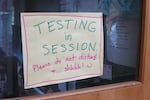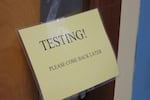For students and teachers who have spent months grappling with the difficulties of school from home, Portland Public Schools is rolling out another challenge: standardized testing from home.
Oregon’s largest district is preparing its staff to test students starting as soon as next week, in order to measure achievement and learning over the last year — most of which was spent at home, in comprehensive distance learning. That testing window is starting at the same time administrators are ramping up efforts to offer limited in-person instruction at schools across Portland.
But staff from at least 12 Portland schools from all over the district have asked PPS leaders to suspend testing during this time.
“Bridlemile teachers understand the level of stress and trauma the community is currently experiencing and believe MAP testing will cause additional harm to students and families,” reads one letter from Bridlemile Elementary School, in Portland’s southwest hills.
There are letters from parent-teacher associations, in support of educators.
“We are in agreement that the instructional time lost, data unreliability and the furthering of racial inequity provide a strong case for revising this decision,” reads a letter signed by the PTA at Abernethy Elementary, in inner Southeast Portland.
From Forest Park to North Portland’s Rosa Parks elementary schools, the letters all make the same case: educators say testing will not provide reliable data, will disrupt class time, and will further racial inequities.

With the coronavirus pandemic closing most schools in Oregon, districts can't administer tests in classrooms, as pictured in this photo from several years ago. Instead, districts like Portland Public Schools plan to have students take tests from home.
Rob Manning / OPB
Teachers like Alisha Chavez, a K-2 special education teacher at Southeast Portland’s Atkinson Elementary, said she wants to know how her students are doing. But she doesn’t need a standardized test to do that.
“Teachers are like, ‘yes, I do want data, I do want to see where kids are,’ but at the same time — we’re in a pandemic,” Chavez said.
“We’re just going to have to figure out how to support them and how to help them when we get back into school. Giving them an assessment right now isn’t going to help.”
In messages the district has shared with families, officials say the assessment is “an opportunity to better understand and plan for students’ learning needs.”
“The data will only be used for planning purposes and will not be used for evaluative purposes,” according to a recent message.
PPS administrators were unavailable for an interview with OPB.
The MAP assessment is used nationally, designed to measure student achievement over time. It’s different from summative exams that schools typically use every year for accountability purposes. Oregon uses the Smarter Balanced Assessment Consortium, or SBAC, for that, but those tests were suspended for 2020 due to the pandemic. Those annual tests have been controversial in Oregon, where families can easily opt-out of exams, thanks to provisions enacted by state lawmakers.
24 public school districts in Oregon are among thousands across the country that use the MAP tests, according to NWEA, the Portland-based company that created the assessment. 52 private schools in Oregon use the tests.
But teachers and parents say testing now is not worth the time and stress it will likely put on students already
“Even now we’ve got kids that are barely hanging on by a thread,” said David Scholten, a 5th-grade teacher at Abernethy.
“To ask them to take this test ... kids will suffer from this, motivation will drop, you’ll have kids disengaging from school even more as a result of taking this.”
Parent and PTA president at Southeast Portland’s Grout Elementary Julie Bolstad agrees, and questions the district’s commitment to racial equity.
“I do not envy the challenge the District faces to utilize its expenditure of the MAP test and provide its educators meaningful information about their students, but how can it tout the call to work for racial equity one day and require teachers to use it without supports in place for underserved communities the next?” Bolstad said in an email to OPB.
“Our kids are stressed. They need our teachers and the instructional routines in place. We must put their mental health first.”
After canceling in the fall, Portland tries again
Portland Public Schools planned to test students back in the fall. Angela Bonilla was leading the preparation and planning at Scott Elementary, where she is an instructional coach.
“The biggest frustration as we were creating that plan was the nagging feeling of, ‘this isn’t right, this isn’t the time, this isn’t the way,’” Bonilla said.
Several other schools were frustrated enough to push back against district administrators, and PPS relented, deciding not to go forward with testing last fall.
But with testing back on the table for February, Bonilla’s feelings aren’t going away.
“Nothing has changed since the fall to make these circumstances so different that we should continue with testing,” Bonilla said.
In regards to the district’s testing plan, some things have changed since the attempt in the fall. This spring’s testing won’t include the district’s youngest students, and will instead focus on students in grades 3-8. The testing schedule will be more “abbreviated” than in previous years, “with students being asked to spend only one or two hours taking the assessment,” according to PPS.
Teachers say with students in remote setup and small groups, testing will likely take longer than two hours — putting a further dent in instructional time.
Schools are also closer to reopening in-person than they may have been in the fall, with PPS planning to hold testing right as the district rolls out plans to return to in-person learning later this school year.
Part of the district’s reasoning for going through with MAP testing now is due to the likely cancellation of a statewide assessment. It was canceled last year because of COVID-19-related school closures. In a message to families, Chief of Schools Shawn Bird also wrote that the data will be important in February, “as we work through budget planning for next school year” and figure out where to direct resources.
And then there’s the problematic testing environment. Typically, students take the tests in classrooms, with teachers and staff able to help with technical issues or other concerns. At home, that environment will be uncontrolled and differ from student to student.

In a typical year, testing would take place in a controlled environment, like this computer lab at Portland's Abernethy Elementary School. This time around, students are expected to take the tests at home.
Rob Manning / OPB
In person, Bonilla would be able to help students and see if they’re getting frustrated or need a break. Next month, she’ll be there to help Scott students virtually, but she says it may be harder to know when students need help.
“With cameras off, without being physically near them, it’s going to be difficult to gauge that for kids,” Bonilla said. “In the end, a kid can just close their computer and decide, ‘I’m done with this, I don’t want to deal with this anymore.’”
Like with the annual SBAC test, families are able to “opt-out” of the assessment, though that was not clearly communicated in the district’s first message to families earlier this month. In a more recent message to the community, district leaders called the test “voluntary.”
But teachers, including Chavez at Atkinson Elementary, worry that some families, including those whose first language is not English, may not know they have a choice.
“Especially with all the languages that we have, a lot of parents aren’t going to understand that opting out of this particular MAPS testing — there’s an option for that,” Chavez said.
Portland students haven’t done standardized testing in a home environment before.
But students in another Oregon school district have.
“All over the board” — Umatilla’s mixed results from testing at home
As PPS administrators were deciding to put off testing last fall, the Umatilla School District in eastern Oregon held MAP testing, while running classes through distance learning.
It was set to begin the day after storms and a fire had forced families to evacuate their homes. And it continued, with adjustments made for students without power or an internet connection.
“We’ll just adjust for the students who cannot log in this week to be sure they can still have a strong testing environment,” said Umatilla superintendent Heidi Sipe at the time.
Sipe sees the MAP assessment as a way to focus on individual students, even now.
“We share in recognizing that the results will not be a true reflection of each student’s growth because of the at-home testing environments,” Sipe said in an email to OPB.
Taunya Daniel is a math teacher at Clara Brownell Middle School in Umatilla. She usually relies on data from MAP tests to plan instruction and interventions for students.
She didn’t do that with the data from last fall.
“The results were all over the board — some were much lower than when they last took it, some scores were significantly higher, and some scores were right where we would probably expect them to be,” Daniel said.
She said several students did not have a quiet testing environment. She looked at the scores differently this time around and questioned whether the time to test was worth it.
“With this year I don’t feel like the sacrifice of instructional time has been worth it,” Daniel said in an email to OPB. “With much less contact time with students every minute is more valuable than it was last year.”
But at the same time, Daniel wanted her students to see the results of their work, despite all the challenges of distance learning.
“They are attending live classes, doing their work, taking advantage of the help sessions that are available to them,” Daniel said.
“They deserve to see how far they have come and to prove that they are resilient and will not let where and how they learn determine their academic progress.”
Former Umatilla parent and family liaison for the district Isis Ilias had a lot of concerns about the test. As a family liaison in the district, she heard concerns from others too.
“The talk was, ‘they’re not ready, they don’t know anything, it was just summer and we had distance learning before that — they didn’t even log on, they didn’t know how to log on…’ — it was just so much worry,” Ilias said.
“There was a lot of stress and anxiety on families about a test because all we heard was, ‘MAPS testing is coming.’”
She worried about her own daughter whose learning challenges had qualified her for extra support through an Individualized Education Plan. The IEP had been approved right before schools closed in March, and Ilias didn’t want to put her child through testing.
“In your families, you’ve been through a traumatic year,” Ilias said. “When they say testing, it feels really unfair, and that’s where a lot of families were standing.”
But she talked to Sipe and felt more at ease. Sipe convinced her that the information from the test was valuable, and not meant to criticize.
“We all just want to support and love and help these kids because it’s not the time to put any pressure on them,” Ilias said.
And despite a tough year for her family, the test results showed improvement.
Ilias and her husband were able to show her daughter that she’d had learning growth.
“We got to tell her, and she had a lot of confidence afterwards.”
